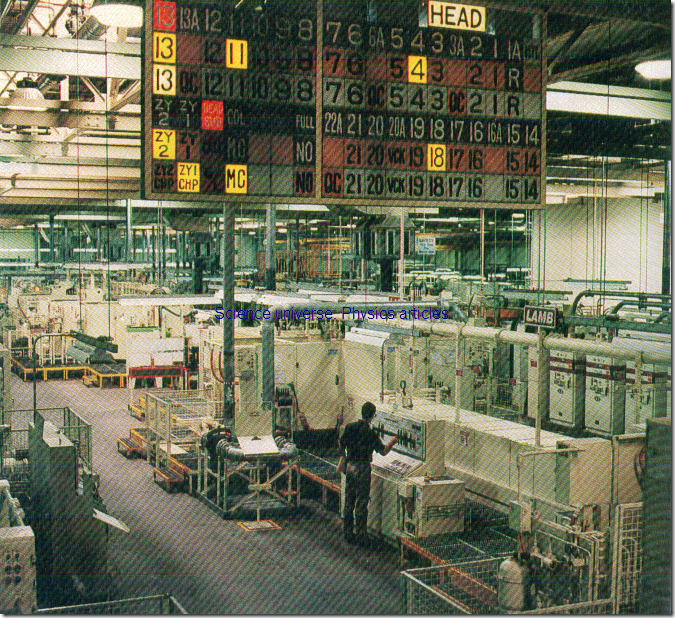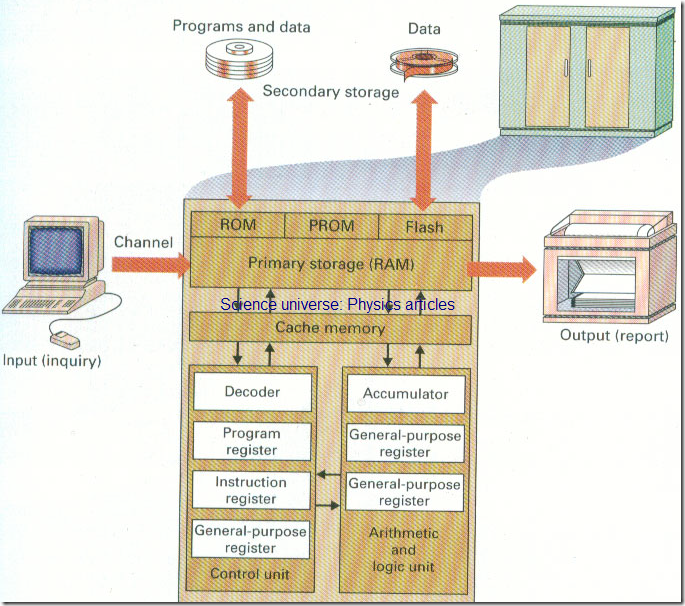COMPONENTS OF A COMPUTER SYSTEM: A CLOSER LOOK AT THE PROCESSOR AND RAM
Let’s review. We have learned that all computers have similar capabilities and perform essentially the same functions, although some might be faster than others. We have also learned that a computer system has input, output, storage, and processing components: that the processor is the "intelligence" of a computer system; and that a single computer system may have several processors. We have discussed how data are represented inside a computer system in electronic states called hits. we are now ready to expose the inner workings of the nucleus of the computer system-the processor.
Literally hundreds of different types of computers are marketed by scores of manufacturers. The complexity of each type may vary considerably, but in the end each processor, sometimes called the central processing unit or CPU, has only two fundamental sections: the control unit and the arithmetic and logic unit. Random-access memory (RAM) also plays un integral part in the internal operation of a processor. These three—random-access memory (same as primary storage), the control unit, and the arithmetic and logic unit-work together. Let’s look at their functions and the relationships between them
RAM: Random-Access Storage
The Technology Unlike magnetic secondary storage devices, such as tape and disk, RAM (primary storage) has no moving pans. With no mechanical movement, data can be accessed from RAM at electronic speeds, or dose to the speed of light. most of today’s computers use CMOS (Complementary Metal-Oxide Semiconductor) technology for RAM. A state-of the-an CMOS memory chip about one eighth the size of a postage stamp can store about 4.000,000 bits, or more than 400,000 characters of data!
But there is one major problem with semiconductor storage, it is volatile memory. That is, when the electrical current is turned off or interrupted, the data are lost. Researchers are working to perfect a RAM technology that will retain its contents after an electrical interruption. Several nonvolatile memory technologies, such as bubble memory, have emerged, but none has exhibited the qualities necessary for Widespread application. However, bubble memory is superior to CMOS for use in certain computers. it is highly reliable, it is not susceptible to environmental fluctuations, and it can operate on battery power for a considerable length of time. These qualities make bubble memory well-suited for use with industrial robots and in portable computers.
Nonvolatile bubble memory is frequently the memory of choice for computer controlled machine tools that must operate in harsh environments . this automated machining system produced cylinder heads at Toyota’s car manufacturing facility in Kentucky .
Function RAM provides the processor with temporary storage for programs and data. All programs and data must be transferred to RAM from disk device (such as a keyboard) or from secondary storage (such as a disk) before programs can be executed or data call be processed RAM space is always at a premium; therefore, after a program has been executed . the storage space it occupied is reallocated to another program awaiting execution .
Figure 4 illustrates how all Input/output (I/O) is "read to" or "written from" RAM. In the figure, an inquiry (input) is made on a VDT. The inquiry in the form of a message, is routed to RAM over a channel. The channel is a pathway over which signals are transmitted between devices in a computer system. The message is interpreted and the processor initiates action to retrieve the appropriate program and data from secondary storage. The program and data are "loaded." or moved, to RAM from secondary storage. This is a nondestructive read process. That is the program and darn that are read reside in both RAM (temporarily) and secondary storage (permanently). The data are manipulated according to program Instructions, and a report is written from RAM to a printer.
A program instruction or a piece of datum is stored in a specific RAM location called an address, Addresses permit program instructions and data to be located, accessed. and processed. The content of each address is constantly changing as different programs are executed and new data are processed.
RAM, ROM. and PROM A special type of RAM. called read-only memory (ROM), cannot be altered by the programmer. HOM (rhymes with
FIGURE 4 Interaction between Primary Storage and Computer System Components All programs and data must be transferred from an input device or from secondary storage before programs can be executed and data can be processed During processing. instructions and data are passed between the various types of interned memories. the control unit . and the arithmetic and logic unit . output is transferred to the primer from primary storage.
mom), a nonvolatile technology, is introduced briefly in previous topics . "Interacting with Computers." The contents of RAM ,’" are "hard-wired" (designed into the logic of the memory chip) by the manufacturer and can be "read only." When you rum on a microcomputer system, a program in ROM automatically readies the computer system for use. Then the ROM program produces the initial display-screen prompt .
A variation of ROM is programmable read-only memory (PROM).
PHOM is HOM into which you. the user, can load "read-only" programs and data Some microcomputer software packages, such as electronic spreadsheets, are available as PROM units as well as on interchangeable disks. Generally, once a program is loaded to PROM. it is seldom, if ever changed flash memory is a type of PROM that can be altered easily by the end user. Flash memory is a feature of many new I/O and storage devices. The intelligence of these devices can be upgraded by simply downloading new software from a vendor-supplied disk to flash memory. upgrades to early peripheral devices required the user to replace the old circuit board or chip with a new one.
Cache Memory Programs and data are loaded to RAM from secondary storage because the time required to access a program instruction or piece of datum from RAM is significantly less than from secondary storage. Thousands of instructions or pieces of data can be accessed from RAM in the time it would take to access a single piece of data from disk storage RAM is essentially a high-speed holding area for data and programs. In fact, nothing realty happens ill a computer system until the program instructions and data are moved from RAM to the processor. This transfer of instructions and data to the processor can be time-consuming, even at microsecond speeds. To facilitate an even faster transfer of instructions and data to the processor, some computers are designed with cache memory (see Figure 4). Cache memory is employed by computer designers to increase computer system throughput. Remember from previous topics , "Computer Systems: Micros to Supercomputers," throughput refers to the rate at which work can be performed by a computer system.
Like RAM cache is a high-speed holding area for program instructions and data. However, cache memory uses a technology that is about 10 times faster than RAM and about 100 times more expensive. With only a fraction of the capacity of RAM . cache memory holds only those instructions and data that are likely to be needed next by the processor.



